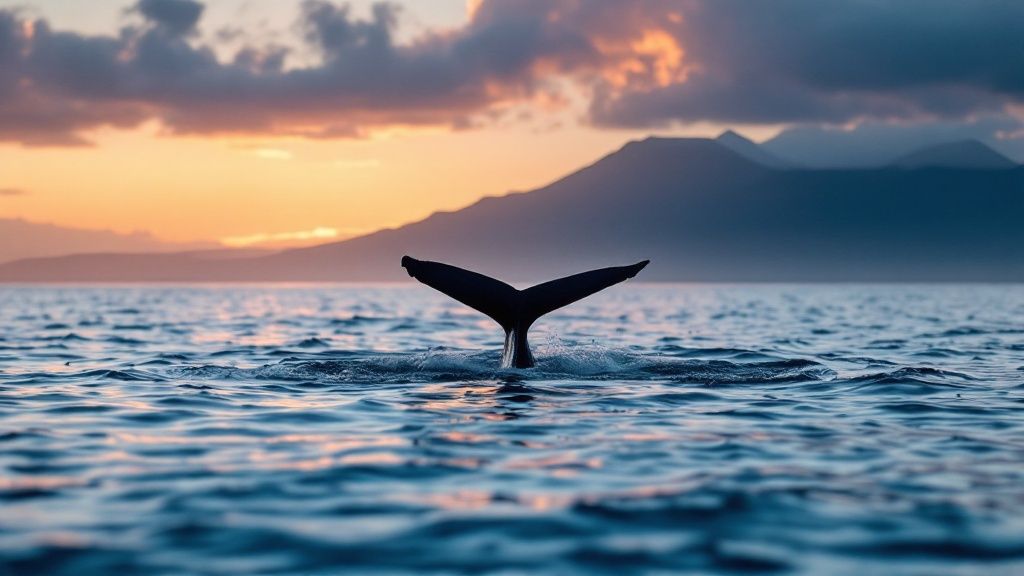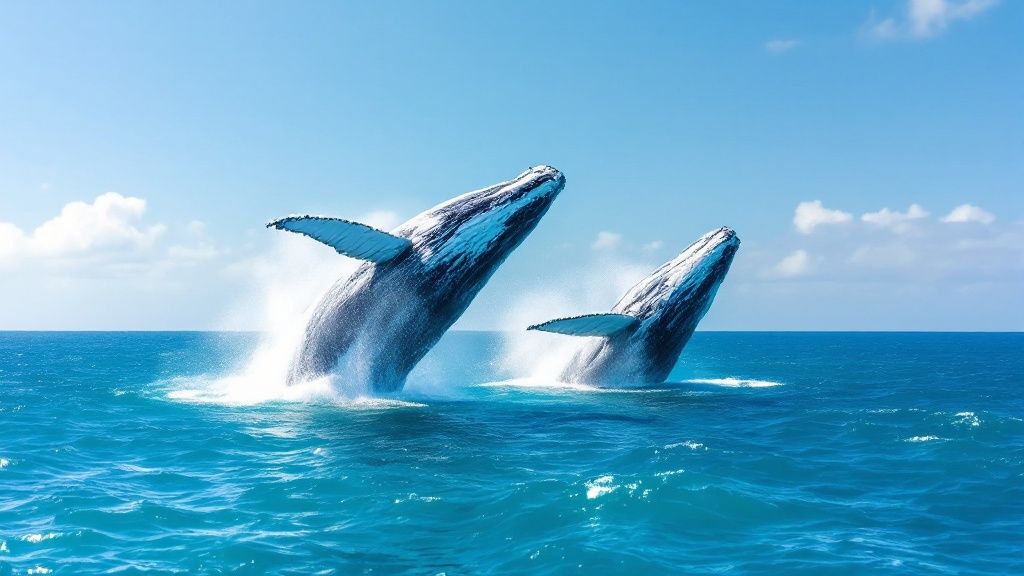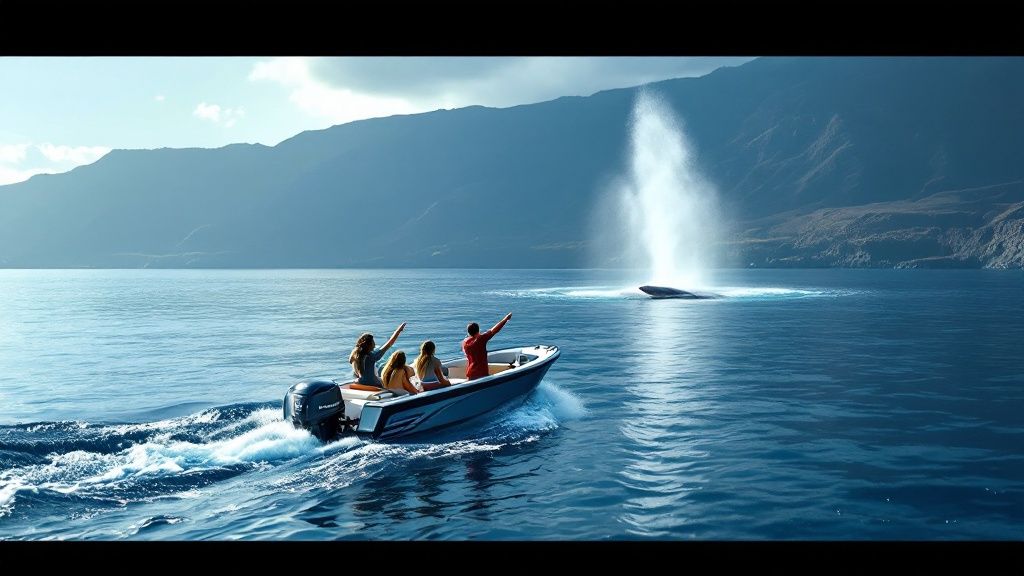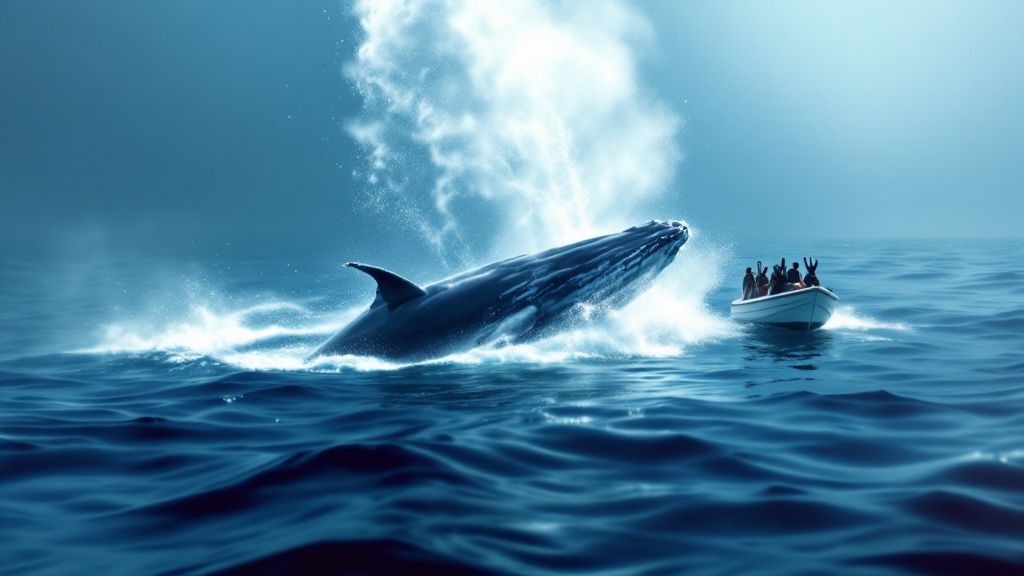Whale Watching Kona Big Island | Your Ultimate Guide

Picture this: the brilliant turquoise water off the Kona coast suddenly explodes as a 40-ton humpback whale launches its entire body into the air. This isn't something you only see in nature documentaries—it's a very real, and surprisingly common, sight during whale season on the Big Island. When it comes to incredible marine encounters, Kona is Hawaii's top spot, offering some of the most reliable and flat-out spectacular whale watching anywhere on the planet.
As the top rated & most reviewed snorkel company in Hawaii, Kona Snorkel Trips is ready to give you a front-row seat.
Witnessing the Gentle Giants of Kona
The annual humpback whale migration is one of nature's greatest shows, and the Big Island gives you a front-row seat. Every year, from late fall to early spring, thousands of these incredible animals travel over 3,000 miles from their chilly feeding grounds in Alaska to the warm, protected waters of Hawaii. They make this epic journey for one reason: to breed, give birth, and raise their newborn calves in a safe, calm environment.

This guide is your playbook for experiencing this natural wonder for yourself. We'll get into why Kona's calm seas are such a magnet for whales, help you nail down the best times for a guaranteed sighting, and give you the inside scoop on choosing a tour that puts these gentle giants first.
Your Guide to an Unforgettable Adventure
Knowing what to look for can turn a good day on the water into a truly mind-blowing one. This is about more than just seeing a distant tail fluke; it's about getting a glimpse into the complex behaviors and appreciating the sheer size of these animals. For a world-class experience, you can't go wrong with Kona Snorkel Trips, the top-rated and most-reviewed snorkel and tour company in all of Hawaii. Their expert crews live and breathe these waters, and a trip with them offers insights you just can't get on your own.
Here's what this guide will arm you with for planning your trip:
- Why Kona is a whale magnet: We'll break down the unique geography that makes this the perfect nursery for humpbacks.
- Optimal timing for your visit: Learn the peak season, the best months, and even the right time of day to head out.
- Choosing the right tour: Get a handle on the different types of boats and what makes a tour operator stand out from the rest.
- Respectful wildlife viewing: Understand why ethical practices are so important for protecting the whales for years to come.
A great whale watching tour isn’t just about seeing whales; it’s about understanding their world. An expert guide can interpret behaviors like a thunderous breach or a communicative tail slap, adding a rich layer of context to the spectacle.
With this info, you'll be ready to plan a memorable and respectful whale watching Kona Big Island adventure, connecting you with one of the most awe-inspiring events the ocean has to offer.
Why Kona Is a Humpback Whale Haven
Ever wonder what makes the Kona coast of the Big Island so irresistible to humpback whales? The secret is in the island's incredible geography. The colossal volcanoes of Mauna Loa and Hualalai stand like giant bodyguards, shielding the coastline from the powerful trade winds that pound other parts of Hawaii. This creates a massive, protected bay with water so calm it feels like a different world.

It’s this tranquil marine environment that makes the perfect nursery for mother whales to give birth and raise their newborn calves. These animals undertake an epic journey to get here, migrating a staggering 3,000 miles from their Alaskan feeding grounds to these warm, sheltered waters every single year. For the months they're here, these gentle giants put all their energy into raising the next generation, fasting completely until they head back north. You can find more incredible insights on this migration and Kona's unique habitat over on the Kona Snorkel Trips blog.
Decoding Whale Behavior
When you're out there on the water, you’re not just watching random splashing. You're witnessing a complex and beautiful language. Knowing what these behaviors mean adds a whole new level of awe to your whale watching Kona Big Island experience.
Here are a few key moves to watch for:
- Breach: This is the showstopper—the whale launching its entire body out of the water. Scientists figure it could be anything from a form of communication, a way to knock off skin parasites, or maybe just pure, unadulterated joy.
- Tail Slap (Lobtailing): A massive slap of the fluke on the water’s surface creates a thunderous sound that can travel for miles. It’s often used as a warning to other whales or simply a way to shout across the distance.
- Pectoral Fin Slap: You'll see a whale roll onto its side and repeatedly slap its long pectoral fin against the water. This is another type of communication, almost like waving, and you’ll often see it during social get-togethers.
- Spyhopping: This is when a whale pokes its head straight out of the water to have a look around. It's pure curiosity, allowing them to get a better view of whatever is happening on the surface.
Seeing a calf practice breaching next to its mom is something you'll never forget. These smaller, more energetic jumps are a critical part of the calf's training, building the strength and coordination needed for the long, tough journey back to Alaska.
The Perfect Nursery Conditions
Kona's unique mix of features creates the ideal haven. The warm, shallow waters provide a safe space for calves, which are born weighing about a ton but don’t have the thick blubber they need to survive the frigid Alaskan seas just yet. The ocean's calmness helps conserve precious energy for both mothers and their young, who need to focus on nursing and growing strong.
On top of that, while the deep offshore waters drop off quickly, the nearshore areas are relatively safe from major predators like orcas. This geographical sweet spot gives the vulnerable calves a much better shot at survival. It’s this perfect blend of shelter, warmth, and safety that truly makes Kona the ultimate humpback whale sanctuary.
The Best Time for Whale Watching in Kona
Timing is everything when it comes to planning a whale watching adventure in Kona. Sure, the humpbacks grace our waters from November through April, but picking the right month—and even the right time of day—can be the difference between a pleasant boat ride and a truly mind-blowing encounter.

Think of the whale season as a bell curve. The first arrivals start trickling in around late November, and their numbers slowly build. But if you want to be here for the main event, you'll want to aim for the absolute peak.
Pinpointing Peak Whale Season
For the highest concentration of whales, plan your trip for January and February. During these two months, the waters off the Kona and Kohala coasts are absolutely electric with activity. This is when the migration from Alaska is in full swing, turning the ocean into a bustling nursery, singles bar, and playground for humpbacks.
Don't just take my word for it. Long-term volunteer efforts like the Sanctuary Ocean Count, which has been tracking sightings since 1996, back this up with hard data. Their research shows that sightings along the Kohala coast are two to three times higher during this peak period than any other time.
We're talking an average of 3 to 6 whales spotted every 15 minutes in January and February, with some hotspots reporting up to 15-20 whales in that same window! It’s an incredible spectacle. For a deeper dive into how this data helps us predict the action, check out our Big Island whale watching seasons guide.
Kona Whale Watching Season At a Glance
To help you visualize the flow of the season, here’s a quick breakdown of what to expect month by month.
| Month | Whale Activity Level | Typical Sightings |
|---|---|---|
| November | Low | First arrivals, occasional spouts. |
| December | Moderate | Numbers are building, more consistent sightings. |
| January | Peak | High density of whales, lots of surface activity. |
| February | Peak | The busiest month; best chance for breaches. |
| March | High to Moderate | Whales begin migrating north, but still plenty to see. |
| April | Low | Last of the whales are heading out. |
This table makes it pretty clear: for the best odds of seeing spectacular behavior, January and February are your golden ticket.
The Best Time of Day for a Tour
Once you've zeroed in on the right month, picking the time of day is your next strategic move. While any time on the water is a good time, morning tours often have a clear advantage. Why? The wind.
Early morning trips usually mean calmer, glassier seas because the daily trade winds haven't had a chance to really kick up yet. That smooth surface makes it so much easier to spot a distant spout, the slap of a tail fluke, or the dark shadow of a whale just beneath the water.
The difference is statistically significant. Morning counts around 8:00 a.m. are roughly 50% higher than midday sightings. The combination of calm water and better light gives you the perfect conditions.
As the season rolls into March, the whale population drops by about half as they start their long journey back north. You'll still see them, of course, but that incredible density from January and February is gone. By booking a morning tour during these peak months, you're stacking the deck in your favor for the ultimate whale watching Kona Big Island experience.
Choosing Your Ideal Whale Watching Tour
Picking the right tour can literally make or break your whale watching experience here in Kona. It’s not just about getting on any old boat; it’s about matching the trip to your personal style, the size of your group, and what you’re really hoping to get out of your time on the water. A little homework goes a long way in making sure your adventure is comfortable, captivating, and something you'll talk about for years.

The kind of boat you’re on really shapes the whole adventure. Each one gives you a completely different vantage point for seeing these magnificent animals.
Comparing Different Tour Vessels
Think of the boat as your platform for adventure. Kona has options that cater to just about everyone, from big, stable boats loaded with creature comforts to zippy rafts that put you right in the action.
- Large Catamarans: These are the workhorses of the whale watching world. Their dual-hull design makes them incredibly stable, which is a huge plus for families with little kids or anyone who gets a bit wobbly on the water. They usually come equipped with perks like restrooms, shaded areas, and snacks, putting comfort first.
- Smaller Rafts (Zodiac-style): If you're looking for a bit more of a thrill, a rigid-hulled inflatable raft delivers an up-close-and-personal ride. These boats are smaller and faster, sitting low to the water for an incredible, eye-level view of the whales. You'll feel every bit of the action, but just know it’s going to be a bumpier, splashier trip!
No matter the boat, an experienced captain and a knowledgeable naturalist are absolute must-haves. A great captain knows how to safely and respectfully position the boat for the best views, while a naturalist makes the whole thing come alive by explaining whale behaviors and sharing amazing facts about their lives.
What Makes a Tour Operator Stand Out
Beyond the boat itself, the quality of the tour operator is what truly matters. You want a company that’s committed to ethical and responsible wildlife viewing. That ensures your incredible experience doesn't stress out the whales. Look for operators who are part of the Dolphin SMART program or who are vocal about following federal viewing guidelines, which means staying at least 100 yards away from humpback whales.
Another game-changing feature to look for is a hydrophone. This is an underwater microphone the crew can lower into the ocean, letting you listen to the haunting, complex songs of the male humpbacks. Hearing those calls broadcast live through the boat is a deeply moving experience and creates a connection you just can't get any other way.
For a deeper dive into picking the right company, you can check out our guide to the best whale watching tours in Kona. At the end of the day, an operator with genuine passion for marine life and a dedication to education is what turns a simple boat ride into a truly profound wildlife encounter.
Discovering Kona's Diverse Marine Wildlife
While everyone comes to see the magnificent humpback whales—and for good reason—a whale watching Kona Big Island tour is so much more than that. Think of it as a full-blown marine safari, where the supporting cast is just as incredible as the main event. The waters off the Kona coast are absolutely teeming with life, turning every moment on the boat into a chance for a new discovery.
Your whale watching adventure will almost certainly include run-ins with some of Kona's other famous residents. You'll want to keep a sharp eye out for the acrobatic spinner dolphins, which love to travel in big, playful pods. It’s pretty common to see them leaping and twisting through the air in a dazzling display that can give even the mightiest whale breach a run for its money.
More Than Just Whales
Look beyond the dolphins, and you’ll find the deeper waters hold even more secrets. You might come across various toothed whales, like the highly social and curious pilot whales, or maybe you'll catch a rare glimpse of the more elusive pantropical spotted dolphins. The ecosystem here is a vibrant, interconnected tapestry of marine giants.
Kona's coastal waters are remarkably diverse, supporting over a dozen species of toothed whales in addition to the seasonal humpbacks. These waters are also a sanctuary for majestic manta rays, green sea turtles (honu), sharks, and even the occasional, truly massive whale shark. The consistently calm conditions here make Kona one of the most reliable and exciting wildlife watching destinations on the planet.
An Underwater World of Wonders
The list of potential sightings just keeps going, a true testament to the health and richness of this protected marine environment.
- Honu (Green Sea Turtles): You'll often see these ancient mariners gliding gracefully near the surface. They're a common and beloved sight for everyone on board.
- Manta Rays: Kona is world-famous for its manta ray population. While they're most active at night, daytime sightings definitely happen!
- Whale Sharks: Spotting one is rare, but encountering the largest fish in the sea is a real possibility—a genuine, once-in-a-lifetime thrill for the lucky few.
Once you grasp the sheer breadth of marine life here, your tour transforms. It's no longer just a whale watch; it's a deep dive into a world-class ocean habitat. Each trip offers a unique window into this complex and beautiful ecosystem.
Speaking of incredible residents, the giant manta rays are particularly active after dark. If you're fascinated by these gentle giants, you can learn all about the unforgettable experience of a night snorkel with manta rays in Hawaii in our detailed guide. It’s the perfect adventure to complement a day spent watching whales.
Got Questions About Kona Whale Watching?
Heading out on the water is always an adventure, and it’s totally normal to have a few questions before you go. Getting the details sorted out ahead of time means you can just kick back, relax, and soak in the experience once you're on the boat. To help you get prepped, here are the answers to the questions we hear most often.
What Should I Bring on the Tour?
A little preparation goes a long way in making a great day even better. The Hawaiian sun is no joke, especially with the glare coming off the water, so you'll want a small bag with a few key items to stay comfortable.
- Sun Protection: This is non-negotiable. Pack some reef-safe sunscreen, a good hat that won’t fly off in the breeze, and a pair of polarized sunglasses. Trust me, the sunglasses make a huge difference in cutting the glare so you can actually see the whales better.
- Layers: Even on the warmest Kona days, it can get surprisingly chilly out on the open ocean with the wind. A light jacket or windbreaker is always a smart move.
- Camera or Smartphone: You're going to want photos of this! Make sure your phone or camera is fully charged and, if you can, stick it in a waterproof case or bag just to be safe.
Are the Tours Okay for Young Kids?
Absolutely! Most of the whale watching tours here in Kona are fantastic for the whole family. If you’ve got little ones, I'd steer you toward the larger, more stable boats like catamarans. They offer a much smoother ride and have plenty of space for kids to move around without feeling cooped up.
That said, it never hurts to double-check with the specific company you book with. Let them know you have kids and ask about any age recommendations, especially if you're looking at a smaller raft-style boat—those can be a pretty bumpy ride.
What Happens if We Don't See Any Whales?
This is a big one, and it's a fair question. We're dealing with wild animals here, and they're on their own schedule. While sightings are incredibly common during the peak season—especially January and February—there's never a 100% guarantee.
The good news is that most reputable tour operators get this and offer some kind of "whale guarantee." This usually means if you don't spot any whales, you can join another tour for free on a standby basis. Always ask about this policy when you're booking; it really offers great peace of mind.
How Can I Keep from Getting Seasick?
Nobody wants their trip ruined by motion sickness. If you know you're a bit prone to it, there are a few simple things that can make all the difference. You might want to take an over-the-counter remedy before the tour starts, just follow the directions on the box.
Once you’re on the boat, find a spot with plenty of fresh air and try to keep your eyes on the horizon—it really helps your brain stabilize. It's also a good idea to stay hydrated and maybe skip that big, greasy breakfast right before you head out.
Ready to see these gentle giants up close? For an unforgettable adventure that’s small, personal, and respectful of the whales, come join us. Book your tour with Kona Snorkel Trips, and let our experienced crew show you the best whale watching experience on the Big Island.
